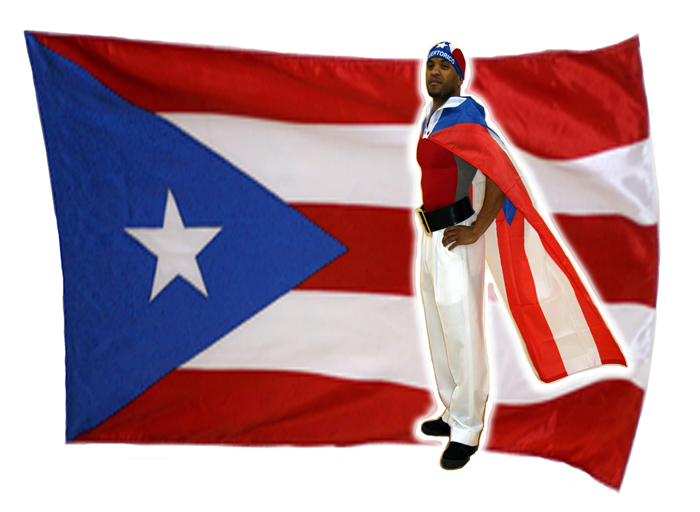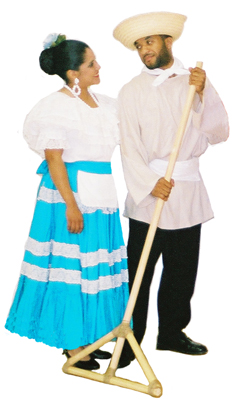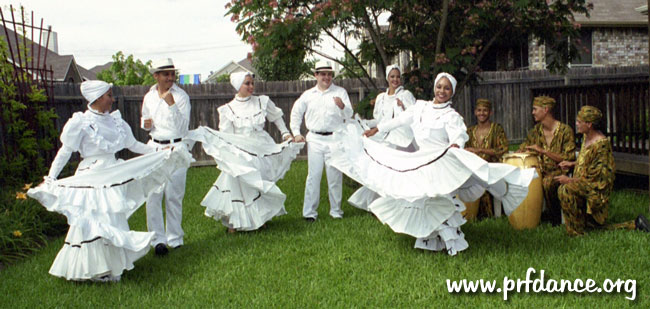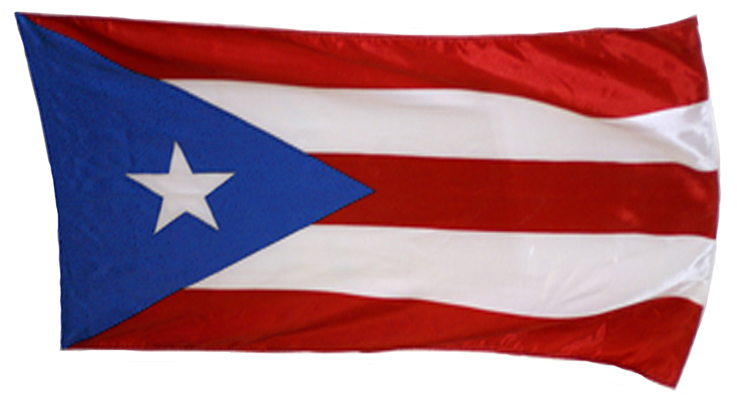













Puerto Rican Folkloric Dance
Sembrando Herencia 2006
PiraguaMan!!
The History behind the Musical
by Dr. Tekina-eiru Maynard (2006)
"Cuando Puerto Rico comprenda el valor de su folclor,
luchara' con mucha fuerza para defender su honor."
-- Don Rafael Cepeda Atiles
In December 2006, audiences cheered and sang along during Puerto Rican Folkloric
Dance's original mini-musical "PiraguaMan!!"
as PRFDance's SuperHero fought to save Puerto Rico from destruction!
This PRFDance original bilingual musical was created by PRFDance
Director Ana Maria Maynard, in collaboration with Rupert Reyes,
Director of Teatro Vivo. Although PiraguaMan and his adventures are purely
fictional, our story is rich in Puerto Rican history and traditions.
Enjoy our historical investigation on 18th to early
19th century Puerto Rican history which we researched to create our story.
It is in these powerful, historical settings that our
delightful, funny, action-adventure musical takes place.
The Arrival of Coffee in Puerto Rico (1736)
 Until the late 17th Century, almost all coffee in the world was grown by
protective Arabian plantation owners who prohibited strangers from visiting
their plantatation and forbidded seeds from leaving the country. Their
monopoly was broken by Dutch coffee spies, who managed to steal,
cultivate and freely distribute coffee plants throughout Europe, including
France. The first coffee plant to cross the ocean to the Americas
was brought by a French Naval Officer, Captain Gabriel Matthieu de Clieu
in 1720. Across the wide ocean, the Captain defended his little tree from
all kinds of attacks (even Pirates) and kept the little coffee plant
alive by sharing his drinking water. Coffee was introduced to Puerto Rico
in 1736 from Santo Domingo and grew well in the protected rainforest canopy of
the high mountains of the island. At that time, decendants of Spanish
immigrants, humble and hardworking mountain people called "Jibaros," worked the
inland farms in the mountains of Puerto Rico.
Coffee became an important Puerto Rican commodity in the 1800s when
events in Europe forced French and Italian immigrants from Corsica
to settle in Puerto Rico. For them it was an island of similar geography with
an attractive offer from Spain -- free land for those who wanted to
start a new life on the island.
With the coastal areas fairly settled, Corsicans settled in the
southwestern highlands, especially around the town of Yauco and made coffee
an island success.
By 1896, Puerto Rico had become the world's sixth-largest coffee exporter.
Until the late 17th Century, almost all coffee in the world was grown by
protective Arabian plantation owners who prohibited strangers from visiting
their plantatation and forbidded seeds from leaving the country. Their
monopoly was broken by Dutch coffee spies, who managed to steal,
cultivate and freely distribute coffee plants throughout Europe, including
France. The first coffee plant to cross the ocean to the Americas
was brought by a French Naval Officer, Captain Gabriel Matthieu de Clieu
in 1720. Across the wide ocean, the Captain defended his little tree from
all kinds of attacks (even Pirates) and kept the little coffee plant
alive by sharing his drinking water. Coffee was introduced to Puerto Rico
in 1736 from Santo Domingo and grew well in the protected rainforest canopy of
the high mountains of the island. At that time, decendants of Spanish
immigrants, humble and hardworking mountain people called "Jibaros," worked the
inland farms in the mountains of Puerto Rico.
Coffee became an important Puerto Rican commodity in the 1800s when
events in Europe forced French and Italian immigrants from Corsica
to settle in Puerto Rico. For them it was an island of similar geography with
an attractive offer from Spain -- free land for those who wanted to
start a new life on the island.
With the coastal areas fairly settled, Corsicans settled in the
southwestern highlands, especially around the town of Yauco and made coffee
an island success.
By 1896, Puerto Rico had become the world's sixth-largest coffee exporter.
Segundo Ruiz Belvis - 1st fighter for abolition of slavery in PR (1865)
As those who follow our cultural traditions know, Bomba is a popular music
and dance tradition created in Puerto Rico. First developed at the end of the 17th century, Bomba flourished along the coast of Puerto Rico where West Africans and their descendants worked the colonial sugar canes.
Segundo Ruiz Belvis was the first to fight for abolition of
slavery in Puerto Rico. After obtaining his law degree from the Central
University of Madrid, he returned to Puerto Rico and freed the slaves in his
hacienda (1859). He returned to Madrid in 1865 as a representative for the
abolitionist cause in front of the Spanish Courts. Even though his ideas were
viewed as dangerous by the Spanish rulers, and caused him to be exiled from
Puerto Rico, it was nonetheless the beginning of a movement which would
eventually lead to the liberation of the slaves in Puerto Rico (1873) and the
remaining Spanish Colonies in Latin America (which he unfortunately did not
live to see). Belvis was also known for his work with Ramon Emeterio Betances
and other compatriots in what would become known as the "Grito de Lares." But that is another subject for future research!

The Birth of the Puerto Rican Flag (1895)
 By 1892, Puerto Rico and Cuba were the only two Spanish
colonies in the Western Hemisphere that remained under Spanish rule. In 1895, a
combined group of Puerto Rican and Cuban revolutionaries organized to work
together to obtain independence from Spain. As part of their efforts, they
created a flag that would be a symbol of their cause. It remains unclear who
was the actual designer, however, in December 22, 1895, at a general assembly,
the PR flag was adopted. The design -- the Cuban flag, simply inverted. Our
flag consists of 5 stripes that alternate from red to white: the red stripes
representing the blood from the brave warriors, and the white stripes
representing the victory and peace that they would have after gaining
independence. To the left of the flag, a blue triangle houses one white
five-pointed star, representing the beautiful island of Puerto Rico.
By 1892, Puerto Rico and Cuba were the only two Spanish
colonies in the Western Hemisphere that remained under Spanish rule. In 1895, a
combined group of Puerto Rican and Cuban revolutionaries organized to work
together to obtain independence from Spain. As part of their efforts, they
created a flag that would be a symbol of their cause. It remains unclear who
was the actual designer, however, in December 22, 1895, at a general assembly,
the PR flag was adopted. The design -- the Cuban flag, simply inverted. Our
flag consists of 5 stripes that alternate from red to white: the red stripes
representing the blood from the brave warriors, and the white stripes
representing the victory and peace that they would have after gaining
independence. To the left of the flag, a blue triangle houses one white
five-pointed star, representing the beautiful island of Puerto Rico.
HISTORICAL REFERENCES:
- Wagenheim, Kal and Jimenez de Wagenheim, Olga, "The Puerto Ricans: A
Documentary History," Markus Wiener Pub., 1996. (Before I read this book, I hated history. ;) A facinating book that presents history in the words of those who were there.)
- Jimenez de Wagenheim, Olga, "Puerto Rico: An Interpretive History from
Pre-Columbian Times to 1900," Markus Wiener Pub., 1998.
- Kal Wagenheim, "Puerto Rico: A Profile", Praeger Publishers, New York NY, 1970.
- Morales Carrion, Arturo, "Puerto Rico: A Political and Cultural
History," W. W. Norton & Company, Inc., 1983.
- Pico Fernando, "Historia General de Puerto Rico," San Juan, PR: Ediciones
Huracan, 2000.
- The Book of Coffee and Tea: Second Revised Edition, Joel Schapira, Karl Schapira, David Schapira, St. Martin's Griffin Publisher, March 15, 1996.
- "Mountain Gold: Puerto Rico's Gourmet Coffee," Bienvendios Magazine, Official Visitors Guide of the Puerto Rico Hotel & Tourism Association, Coral Publications, 1999.
- "Corsican Migration to Puerto Rico in the 19th Century - Part 1," Wilfredo Santiago-Valiente, PhD, El Boricua, a cultural newsletter (www.elboricua.com), August 2003.
- "Corsican immigration to Puerto Rico, From Wikipedia, the free encyclopedia, http://en.wikipedia.org/wiki/Corsican_immigration_to_Puerto_Rico
- "An Introduction to the Coffee History of Puerto Rico and Yauco Selecto'S Part in that History," Yauco Selecto Literature, http://www.tastesoftheworld.net/information.php?info_id=16
- Website for Hacienda Buena Vista in Ponce, http://www.gicco.com/19thCentury.htm
- "Puerto Rico Joe Sampling an island's coffee," Christopher Hall, San Francisco Chronicle, Sunday, October 14, 2001,
http://www.sfgate.com/cgi-bin/article.cgi?file=/chronicle/archive/2001/10/14/CM92860.DTL
- Interviews and teaching from Joquain Nieves Caldero, Folklorist from Corozal and Director of Guateque de PR, 2003.
- Los Pleneros De La 21, "Somos Boricuas/We Are Puerto Rican: Bomba Y Plena En Nueva York," Henry Street 1996. Historical notes (liner) by ethnomusicologist and folklorist Roberta L. Singer.
- "Segundo Ruiz Belvis: Un canto al sacrificio y a la libertad," Luis R. Negron Hernandez, Puerto Rico En Breve (PREB.com), http://www.preb.com/biog/srbelvis.htm
- "Una aventura de la memoria: Segundo Ruiz Belvis en la historia de Hormigueros," Mario R. Cancel Recinto Universitario de Mayaguez, http://www.geocities.com/todos_losgatos/Historias_al_margen_2.html
- Segundo Ruiz Belvis, Answers.com, http://www.answers.com/topic/segundo-ruiz-belvis
- Puerto Rican Flag, Evette Zayas (Democratic District Leader) and Yelimar Quinones (68th Assembly District Intern), East Harlem News, May 28, 2004,
http://www.east-harlem.com/mt/archives/000062.html
- Flag of Puerto Rico, From Wikipeida,the free encyclopedia,
http://en.wikipedia.org/wiki/Flag_of_Puerto_Rico
We hold the banner high for Puerto Rico everyday!
Thank you in advance for your donation of any size!!

For more information:
Dr. Ana María Tekina-eirú Maynard
Puerto Rican Cultural Center
Cultural Center Address: 701 Tillery Street #13,
Austin TX 78702-3738 (Map & Directions)
Mailing Address: 15228 Quiet Pond Court, Austin TX 78728-4555
Phone: +1.512.251.8122
Email: dance@prfdance.org
Web: www.prfdance.org
Facebook: www.facebook.com/prfdance
Copyright ©1997-2024 Puerto Rican Folkloric Dance, Inc. All rights
reserved. Terms of use.

 Until the late 17th Century, almost all coffee in the world was grown by
protective Arabian plantation owners who prohibited strangers from visiting
their plantatation and forbidded seeds from leaving the country. Their
monopoly was broken by Dutch coffee spies, who managed to steal,
cultivate and freely distribute coffee plants throughout Europe, including
France. The first coffee plant to cross the ocean to the Americas
was brought by a French Naval Officer, Captain Gabriel Matthieu de Clieu
in 1720. Across the wide ocean, the Captain defended his little tree from
all kinds of attacks (even Pirates) and kept the little coffee plant
alive by sharing his drinking water. Coffee was introduced to Puerto Rico
in 1736 from Santo Domingo and grew well in the protected rainforest canopy of
the high mountains of the island. At that time, decendants of Spanish
immigrants, humble and hardworking mountain people called "Jibaros," worked the
inland farms in the mountains of Puerto Rico.
Coffee became an important Puerto Rican commodity in the 1800s when
events in Europe forced French and Italian immigrants from Corsica
to settle in Puerto Rico. For them it was an island of similar geography with
an attractive offer from Spain -- free land for those who wanted to
start a new life on the island.
With the coastal areas fairly settled, Corsicans settled in the
southwestern highlands, especially around the town of Yauco and made coffee
an island success.
By 1896, Puerto Rico had become the world's sixth-largest coffee exporter.
Until the late 17th Century, almost all coffee in the world was grown by
protective Arabian plantation owners who prohibited strangers from visiting
their plantatation and forbidded seeds from leaving the country. Their
monopoly was broken by Dutch coffee spies, who managed to steal,
cultivate and freely distribute coffee plants throughout Europe, including
France. The first coffee plant to cross the ocean to the Americas
was brought by a French Naval Officer, Captain Gabriel Matthieu de Clieu
in 1720. Across the wide ocean, the Captain defended his little tree from
all kinds of attacks (even Pirates) and kept the little coffee plant
alive by sharing his drinking water. Coffee was introduced to Puerto Rico
in 1736 from Santo Domingo and grew well in the protected rainforest canopy of
the high mountains of the island. At that time, decendants of Spanish
immigrants, humble and hardworking mountain people called "Jibaros," worked the
inland farms in the mountains of Puerto Rico.
Coffee became an important Puerto Rican commodity in the 1800s when
events in Europe forced French and Italian immigrants from Corsica
to settle in Puerto Rico. For them it was an island of similar geography with
an attractive offer from Spain -- free land for those who wanted to
start a new life on the island.
With the coastal areas fairly settled, Corsicans settled in the
southwestern highlands, especially around the town of Yauco and made coffee
an island success.
By 1896, Puerto Rico had become the world's sixth-largest coffee exporter.

 By 1892, Puerto Rico and Cuba were the only two Spanish
colonies in the Western Hemisphere that remained under Spanish rule. In 1895, a
combined group of Puerto Rican and Cuban revolutionaries organized to work
together to obtain independence from Spain. As part of their efforts, they
created a flag that would be a symbol of their cause. It remains unclear who
was the actual designer, however, in December 22, 1895, at a general assembly,
the PR flag was adopted. The design -- the Cuban flag, simply inverted. Our
flag consists of 5 stripes that alternate from red to white: the red stripes
representing the blood from the brave warriors, and the white stripes
representing the victory and peace that they would have after gaining
independence. To the left of the flag, a blue triangle houses one white
five-pointed star, representing the beautiful island of Puerto Rico.
By 1892, Puerto Rico and Cuba were the only two Spanish
colonies in the Western Hemisphere that remained under Spanish rule. In 1895, a
combined group of Puerto Rican and Cuban revolutionaries organized to work
together to obtain independence from Spain. As part of their efforts, they
created a flag that would be a symbol of their cause. It remains unclear who
was the actual designer, however, in December 22, 1895, at a general assembly,
the PR flag was adopted. The design -- the Cuban flag, simply inverted. Our
flag consists of 5 stripes that alternate from red to white: the red stripes
representing the blood from the brave warriors, and the white stripes
representing the victory and peace that they would have after gaining
independence. To the left of the flag, a blue triangle houses one white
five-pointed star, representing the beautiful island of Puerto Rico.
